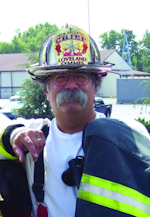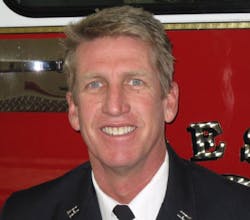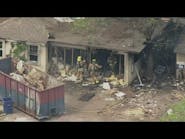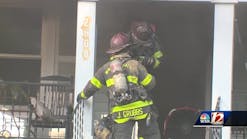Close Calls: Fire Captain Falls Through Roof
Most of you have probably seen the stunning video showing Fresno, CA, Fire Captain Pete Dern falling through the roof into heavy fire conditions at a one-story, single-family dwelling last year. If you haven’t, search YouTube for “Firefighter falls through burning roof in Fresno CA” and watch it—you’ll never think of roof operations the same again, especially those at single-family fires.
Following this fire that severely burned Captain Dern, Fresno Fire Chief Kerri Donis directed a thorough review of the incident—and her department—with the goal of never repeating that unnecessary incident again. Specifically, Chief Donis directed a multi-agency review team to conduct the investigation using veterans from six “outside” departments, among others, to ensure a fair, transparent and accurate review of the incident. The final report of the Cortland Incident can be found on the Fresno Fire Department’s website at fresno.gov/Government/DepartmentDirectory/Fire/default.htm. I highly recommend that everyone review this report, particularly the findings and recommendations, to consider how you can apply the lessons learned to your department.
Risk vs. reward
If you have read this column before, we have made it quite clear that we are of the opinion that some firefighter close calls are not avoidable. Some critical injuries are not avoidable, and even some firefighter line-of-duty deaths (LODDs) are not avoidable. That being said, most ARE avoidable; most close calls, injuries and deaths did NOT have to happen.
There are certainly circumstances where we as firefighters must take risks—sometimes extreme risks—that place us in great danger. Indications, conditions and our size-up all help us decide what risks should be taken and which should be avoided. In the end, the risk should generally be worth it. I say "generally" because we are working in a very time-sensitive environment where decisions must be made immediately.
Size-up matters
Sizing up before and during a fire is critical to determine the outcome to the potential victims and us, the firefighters. Sizing up starts well before the fire. By sizing up our community (or first-due area), we can often closely predict the outcome of an incident. For example, if you’re part of a volunteer fire department with a day response that’s historically low with staffing and slow with response, then the outcome of a fire is pretty predictable. If you’re part of a career fire department with two people on each apparatus and stations that are 10 minutes apart, then it's predictable as far as what your engine company can and cannot do, especially if you don't train and prepare ahead of it.
Be it well before a fire or upon being dispatched or upon arrival, the size up serves as our “game plan” in helping us win or lose. You must establish the following:
- What you are confronted with—this includes identifying your community’s threats well before an incident and identifying the type of structure upon arrival at an incident.
- What you want to accomplish—this includes search, rescue, fire attack and other tactics that may need to be performed, as well as the timeline for doing so.
- What resources are available—this includes apparatus, response time, staffing, the quality of those responding (whether they are trained appropriately, fit for duty, etc.).
Establishing these three things is a simple, yet effective, model for determining the outcome of nearly any fire.
A chief once reminded me that he absolutely trusts me to make decisions, but that I should always be able to fully explain why I did what I did. In other words, he was giving me the trust and responsibility (and plenty of training) and expected me to make decisions based upon what’s best for those having the fire—and the firefighters for whom I am responsible.
Fresno Fire Department
The Fresno Fire Department (FFD) was established in 1877 and is one of the oldest fire departments in the United States. FFD provides fire prevention, suppression and investigation services, airport fire and rescue, urban search and rescue, response to medical emergencies (EMS), and response to hazmat incidents. The FFD service area consists the City of Fresno and two extra-territorial contract service areas (fire districts), totaling 335 square miles.
Staffing for the FFD’s 24 stations is divided among three battalions. The department has 311 authorized sworn safety positions, with 293 filled. Daily FFD sworn firefighter staffing is a total of 73 FFD members on duty each day within the city, plus another 12 minimum daily staffing firefighters through a contracted district.
FFD apparatus staffing includes 1 officer, 1 engineer, 1–2 firefighters on engine companies, 1–2 firefighters on truck companies, and battalion chiefs drive themselves.
The Cortland Incident
While performing vertical ventilation on a residential garage fire, Captain Dern fell into the well-involved fire compartment. There had been penetration of “roof decking burn-through” with direct flame impingement of the lightweight truss, causing the failure. Most roofs are not designed to support firefighters, especially when what is below the roof is on fire.
Captain Dern was engulfed in the fire for more than 90 seconds, and while his bunker gear provided some protection, no bunker gear is designed to protect any of us in those conditions. He suffered second- and third-degree burns over 70 percent of his body.
After 164 days of recovering from burn injuries at Community Regional Medical Center’s Leon S. Peters Burn Center, Truck 4 Captain Dern was able to finally go home on Sept. 9, 2015.
As of this writing, Captain Dern is doing well and continuing with his healing process. After nearly 26 years with the department, Captain Dern officially retired in July 2016 on a medical disability retirement. We all wish him the best.
The more we do things …
Consequences are the result of our actions. Sometimes the consequences are good, and sometimes they are not. After writing this column for nearly 20 years and personally being involved in numerous critical injury and firefighter LODD investigations, it is my opinion that the more we do things wrong, the more they seem right.
Time and time again, we see some departments operate a certain way, and to some observers, it seems proper, and to others, situations have caused them to NOT do “that” anymore. Something going really bad, and someone getting hurt is sometimes the catalyst for change. Death can also force change, as can attorneys knocking on your door.
Clearly, the best way for any of us to change our actions, behavior or even culture is to proactively look at ourselves and our organizations as well as what has happened to others so “that” doesn't happen to us. Unfortunately, there are many examples of how we can all learn to not do “that,” but fortunately, there are forward-thinking and open-minded chiefs, officers, labor leaders and others who understand that although the outcome was bad, they want to do everything they can to ensure that it doesn’t happen again to them—or any other organization.
Chief Donis, her leadership team and the members of IAFF Local 753 get it. They didn't ignore this incident or blow it off as “part of the job,” because a captain falling through the roof of a well-involved dwelling is absolutely NOT part of the job.
I think Chief Donis summarized the reason behind this report and its recommended changes perfectly when she stated: “These are some of the practices and things that have been occurring in this organization for years and years and years. This isn’t something that has just occurred in the last year or since Captain Dern’s incident. We essentially have kind of kicked the can down the road in this department and in other departments and have not really poured a lot of commitment to making cultural change and to change our firefighting practices.”
... the more we do things.
Structure and roof
The response was to a small, one-story, single-family dwelling that was 1,377 square feet with an attached 400-square-foot garage. The structure was built in 1970 of 2 x 4-inch stud and stucco exterior walls, half-inch drywall within the residence. There was no drywall in the garage, except for the firewall between the residence and garage. The roof was a 2 x 4-inch gang nail truss roof with half-inch plywood roof sheeting and a single layer of roofing paper and five layers (re-roofed in 1993) of composition roof shingles.
The interior of the garage was not used for vehicle storage; it was used for general storage and a makeshift living area, complete with a refrigerator, couch, wood pallets and small furniture—complete with combustible contents. The interior of the residence was a series of bedrooms and makeshift cubicles for numerous occupants.
Fire response and operations
At 1322 hrs on March 29, 2015, the Fresno Police Dispatch Center received a 9-1-1 call reporting a residential fire at 1310 E. Cortland Ave.
At 1324 hrs, they dispatched Engines 4, 9, 20, Truck 4 and 11, as well as Battalion 3, to the fire. Engine 5 was just clearing a call a few blocks from the Cortland address and was added to the dispatch. Engine 4 was canceled. Battalion 1 was also nearby and was added, and Battalion 3 was canceled. The first alarm now consisted of Engines 5, 9, 20, Truck 4 and 11, as well as Battalion 1. Engine 5, with a crew of four, was first on scene at 1326 hrs.
The captain from E-5 arrived, established Command and gave a size up, reporting heavy smoke showing, possibly in the attic. The engine had secured its own water supply from a hydrant, and E-5 Firefighter 1 stretched a 1½-inch handline to the front door of the residence, which was on the D side. E-5 Firefighter 2 followed and both firefighters went interior.
The IC ordered the second-due engine to assist with fire attack. The dispatcher told IC that they had reports of people still inside the structure, but Command confirmed that everyone was out.
Command then ordered the first-due truck to handle ventilation and the third engine to handle utilities.
E-5 Firefighter 1 proceeded through the dwelling to a door on the B side of the structure with the hoseline and had heavy smoke and fire through the main door of the attached garage. He hit the fire, and then E-5 Firefighter 2 and the IC assisted pulling additional hose through the front door of the residence. E-5 Firefighter 2 proceeded to pull ceiling and check for extension.
Engine 20 arrived and helped with the fire attack, with one firefighter assisting and the officer and engineer establishing two-out. The captain did a partial 360 at this point. Conditions were now heavy fire in the garage with possible extension into the attic. E-5 Firefighter 1 reported that the bulk of the fire was knocked down in the garage, and the fire did not appear to have extended into the attic, which was later found to be inaccurate.
Engine 9 arrived on scene with a crew of four and secured utilities. The captain of E-9 took independent action to create an opening on the roll-up garage door with hand tools. Truck 11 arrived on scene with a crew of four and staged in front of their apparatus. Battalion Chief 1 arrived and went to the IC’s location.
Truck 4 (with Captain Dern) arrived on scene with a crew of four and asked, “Command, Truck 4, do you want vertical vent?” No response from Command. From the B side door and window, the smoke conditions showed pressurized, turbulent, nasty brown and gray smoke exiting the door.
E-5 Firefighter 1 hit the fire in a fog pattern to the ceiling area of the garage and then reported to Command that it appears that there were multiple rooms in the garage and the fire is not knocked down. E-5 Firefighter 1 then stretched the hoseline into the residence.
E-20 Captain advised by radio that they were attempting to open the garage door and that T-4 was going to ventilate.
T-4 took a ground ladder to the structure on the D side, and Captain Dern masked up and proceeded up the ladder with a rubbish hook. When he got to the top, he sounded the roof with his hook as he walked toward the area over the garage. T-4 Firefighter 1 followed the captain up the ladder with a chainsaw and was about 10 to 12 feet behind Captain Dern.
As the captain walked the roof, the fire in the garage was pushing heavy, aggressive brown and dark gray smoke through all portions of the garage, including the roofline, attic vent, doors, windows and eaves.
“Firefighter in the garage!”
Eight minutes after the initial dispatch, as Captain Dern sounded the roof over the garage, he fell through the roof into the heavy fire conditions in the garage. It’s estimated that the fire had been burning the unprotected structural members of the roof for 12–15 minutes.
The IC and Battalion 1, who had not yet taken Command, were both on the front lawn and witnessed the captain go through the roof (as did civilians watching the fire). They both nearly simultaneously broadcasted a mayday for a firefighter through the roof of the garage. BC-1 stated, “Mayday, mayday, mayday, we have a firefighter in the garage … start an EMS unit.”
There was now heavy fire venting through the roof through the hole created by the fall. E-5 Firefighter 1 backed out and applied water toward the hole created in the roof. E-20 Captain (two-out) left the front porch area, leaving their handline behind, and grabbed a second hoseline near the roll-up garage door and started hitting the fire through a small opening in the garage door. At 1333 hrs, with axes and manpower, the roll-up garage door was removed and additional water was directed into the garage.
Battalion 3 arrived on scene and ordered E-20 Captain to lead the firefighting rescue (RIC 1 Group). He assigned T-11 to become the actual RIC team, and Battalion 3 requested an ambulance. E-5 Firefighter 1 flowed the line through the B side of the garage, and then E-5 Firefighters 1 and 2 made entry into the garage and made contact with Captain Dern.
At the same time, T-11 Firefighter worked his way through the dwelling to the garage where he saw two firefighters attempting to rescue the injured captain, and he assisted with the efforts. The rescue was hampered due to pallets and other items in the garage. E-9 Firefighter 1 also made access through the removed roll-up door by independent action and assisted with the rescue.
The three firefighters removed Captain Dern from the garage at 1335 hrs. He was moved onto the driveway where cooling measures were initiated while waiting for the ambulance unit. At 1337 hrs, the ambulance arrived and transported the captain a few minutes later. From the time of the fall until arrival at the hospital was approximately 15 minutes.
Next month
Next month we’ll review the incident facts in order to help determine if this could happen at your department.
Our sincere thanks to Chief Kerri Donis, Captain Pete Dern and all those operating that day. Additionally, our thanks to those who participated in the investigation and subsequent report of this critical incident so that the fire service can learn from the incident so as to not repeat it.

Billy Goldfeder
BILLY GOLDFEDER, EFO, who is a Firehouse contributing editor, has been a firefighter since 1973 and a chief officer since 1982. He is deputy fire chief of the Loveland-Symmes Fire Department in Ohio, which is an ISO Class 1, CPSE and CAAS-accredited department. Goldfeder has served on numerous NFPA and International Association of Fire Chiefs (IAFC) committees. He is on the board of directors of the IAFC Safety, Health and Survival Section and the National Fallen Firefighters Foundation.






